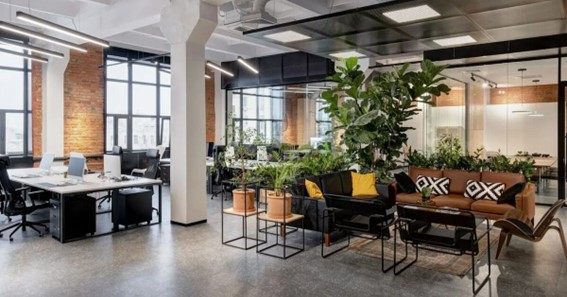Using innovative strategies to foster creativity, productivity, and wellbeing, executive designers are defining future workspaces. An array of decisions – from spatial planning to aesthetic elements – have profound impacts on employee morale and efficiency, so understanding the influence of design is critical.
We’ll uncover three of the key areas you should expect to see changed in office design over the next ten years or so.
How will the future office be designed?
We’re expecting future office spaces to be designed with the following elements in mind:
How will the future office be designed?
We’re expecting future office spaces to be designed with the following elements in mind:
Collaboration
Even with remote working and hybrid contracts on the rise, we’re expecting most large corporations to keep an office in at least one form. Since working patterns are likely to become more flexible, designers will be focusing on social spaces within offices.
Contemporary, collaborative offices might include:
· State-of-the-art digital conferencing rooms and
equipment to connect in-office workers with remote clients and colleagues
· Comfortable and informal seating areas for
socialising, break times, or overflow
· Private booths used for quiet, focused work
without distractions
· Breakout spaces to allow employees to drop by
and work together
Health and safety
On the back of the Covid-19 pandemic, safe and hygienic workspaces are more imperative than ever before. Employers’ responsibilities include reducing the spread of infections within the workplace, so it’s critical to make sure the office promotes good hygiene and can be kept clean.
For this reason, we’re expecting to see office designs that feature:
· One-way systems indicated by arrows on the
floor, especially in high-volume areas
· Improved airflow from open windows and the
installation of ventilation systems
· Overall, a more dispersed office design to avoid
overcrowding and encourage workers to use different workspaces throughout the
day
Reimagined spaces
Employers and employees alike are seeking more efficient ways of using office space. Fluidity will shape the future of large corporate hubs, especially those with multiple teams working across one area.
From the moment the contractors arrive with their Milwaukee packout and complete professional toolkit, offices will be renovated to include the latest features and transformations. New construction projects will be more ambitious than ever before, but we should expect to see plenty of renovations happening in the corporate sector too.
How can productivity be encouraged?
Light
If you’re focusing on productivity in your new office design, try to incorporate as much natural light as possible. Think floor-to-ceiling windows or long, tall windowpanes with plenty of light surrounding the desk areas as well. Just remember to install light blinds to make sure your team can keep working once the afternoon rays hit their screens.
Ergonomic design
Ergonomic office chairs, desks, and computer equipment could make a significant difference to your team’s productivity. Staff can only be at their most productive when they’re working comfortably, so it’s crucial to liaise with your interior designer and make sure that ergonomics are high on the list of priorities.
Overview
Making your staff more productive is no easy feat, but the working environment could influence this factor more than you’d expect. Through collaborative, safe, and reimagined working spaces, teams will start to harness more efficiency than ever before – even through the era of increased remote working.
Click Here – Plasma Skin Tightening Treatments
